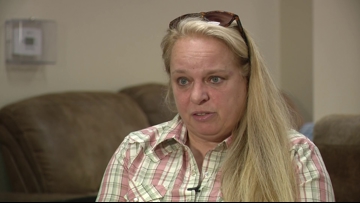- $37M drainage improvement project designed to combat flooding in NE Harris County
- Temporary bridges in Avery County at risk due to severe weather threat
- FEMA extends aid as Hurricane Helene recovery efforts surpass $360M
- Nearly every North Carolina wildfire caused by people, researchers say
- Weather IQ: How do wildfires ignite?
Temporary bridges in Avery County at risk due to severe weather threat

Volunteers built makeshift bridges from salvaged materials to connect isolated communities after Helene, but severe weather could jeopardize their progress.
AVERY COUNTY, N.C. — With the threat of heavy rain in the mountains Thursday night into Friday, many residents in Avery County are concerned the upcoming rainfall could lead to setbacks for those still recovering from Hurricane Helene.
Temporary bridges have been built using salvaged materials, connecting isolated communities with nearby towns so folks can get everyday essentials. One example is a bridge built using a giant tree that’s suspended over the river with boards nailed to the top to form a walkway. However, volunteer groups and other agencies are worried heavy rain could wash away these makeshift structures, putting them back at square one.
“It’s the unknown that continues to rush in,” one person told WCNC Charlotte. “We weren’t prepared, we didn’t know and every day we learn new information.”
Sitting in the Frank Volunteer Fire Department, Robin Ollis, the founder of Bridges for Avery, focuses on what she can learn.
“None of us have been through this,” she said. “So many of us have seen a need and jumped in.”

Amid the destruction across the county and all of western North Carolina, it’s a reminder of the lives that were forever changed by Helene. Homes are still nearly impossible to get to because hundreds of bridges are still out, Ollis noted.
It’s been one roadblock after another, too.
“Number one was finding the funds to build these and then finding out we couldn’t due to limitations by the state,” Ollis lamented. “In North Carolina, we are required to do an engineering study.”
So instead of rebuilding roads, Ollis and her team are building footbridges to help families. While not the most practical, it’s at least something for residents who are completely cut off from essential goods and services. Those families include that of Curtis Stuteville. They were trapped for 51 days without running water, electricity or a way to get across the river.
“You’re stuck,” he said. “It’s been crazy up here, man.”
Stuteville lives in a house on top of a hill with his wife and father-in-law, who was diagnosed with Parkinson’s. When their bridge washed away, he said they were stuck with nowhere to go for weeks.
“It’s not been real good,” he said. “It was terrible.”
As floodwaters receded, he was able to drive his side-by-side through the river and to the other side. Now, the footbridge gives them another option. But there’s still concern that heavy rain could lead to more floods, once again washing out the bridge.
“If the water comes up a couple of inches, it will take it out again,” Stuteville said, stressing his father-in-law’s health could require immediate treatment on a moment’s notice.
But he knows there are people out here doing good and helping in any way they can. Folks like Ollis, who rounded up a crew of strangers to help their community.
“This area here, you can’t ask for no more,” Stuteville said. “We are family, we stuck together.”
Families are still turning toward the county and FEMA for assistance. The response groups say replacement bridges can cost upward of $100,000, something the county says it does not have.
Contact Austin Walker at awalker@wcnc.com and follow him on Facebook, X and Instagram.